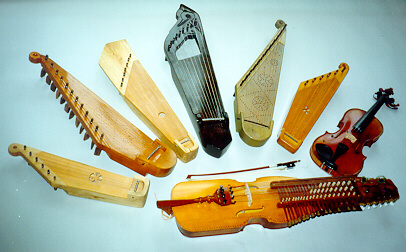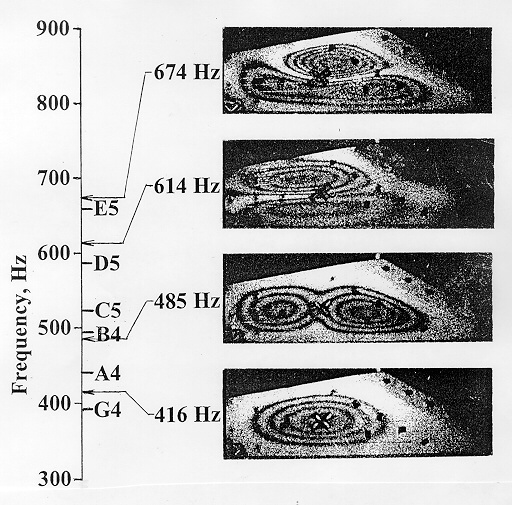Andres Peekna
Innovative Mechanics, Inc.
265 Coe Road
Clarendon Hills, IL 60514-1029
Thomas D. Rossing, Rossing@physics.niu.edu
Physics Department
Northern Illinois University
DeKalb, IL 60115
Popular version of paper 2aMUa1
Presented Tuesday morning, November 2, 1999
138th ASA Meeting, Columbus, Ohio

The Baltic psaltery, a plucked-string instrument, is known in Finland as kantele, in Estonia as kannel, in Latvia as kokle, in Lithuania as kankles, and in northwestern Russia as the wing-shaped gusli. In its archaic form, it had a limited range, circa 5-13 strings, usually tuned diatonically, though the lower strings were somethimes tuned as bourdons, several tones lower than the other strings. The soundbox was hollowed from a single block of wood to which the wooden soundboard was attached. No two instruments were exactly alike.
Six of the instruments in this study are shown in the photo, along with a violin and a Swedish nickelharpa for size comparison. Four of the instruments were constructed by Ain Haas (Indiana University, Indianapolis) and two of them by Andres Peekna. They are patterned after instruments in museums, mostly 100 to 300 years old.
Modes of vibration of the six instruments were determined by using electronic TV holography, which results in a contour map of the soundboard at each resonance frequency. On the main resonances are well distributed in frequency so that they support the various strings of the instrument. The calculated and measured resonance frequencies of the enclosed air cavity were generally found to be in good agreement. Most of the instruments studied have many small sound holes rather than a single large one, as found in most other plucked string instruments.

The lowest vibrational modes of a 6-string kannel are shown in the above figure, along with their relationship to the lowest notes on each string of this kannel. In these holograms, points of maximum motion appear as bulls eyes and areas of minumum motion (nodes) appear as bright lines. Thus the fringe patterns provide contour maps of the instrument as it vibrates.
This study indicates that a good Baltic psaltery should have: (1) strong resonances in the vicinity of the open string frequencies; and (2) sufficient numbers of resonances to support each string of the instrument. The complex asymetric shapes of the instruments may have developed as a way to achieve these in this interesting family of folk instruments.